
A doughnut or donut is a type of pastry made from leavened fried dough. It is popular in many countries and is prepared in various forms as a sweet snack that can be homemade or purchased in bakeries, supermarkets, food stalls, and franchised specialty vendors. Doughnut is the traditional spelling, while donut is the simplified version; the terms are used interchangeably.
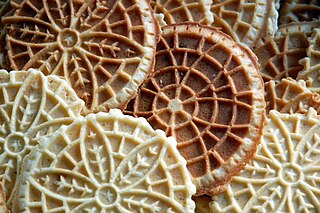
Pizzelle are traditional Italian waffle biscuits made from flour, eggs, sugar, butter or vegetable oil, and flavoring. They can be hard and crisp or soft and chewy depending on the ingredients and method of preparation. Pizzelle can be molded into various shapes, including in the tubular shape of cannoli.
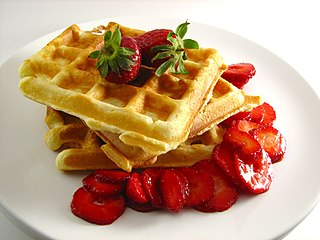
A waffle is a dish made from leavened batter or dough that is cooked between two plates that are patterned to give a characteristic size, shape, and surface impression. There are many variations based on the type of waffle iron and recipe used. Waffles are eaten throughout the world, particularly in Belgium, which has over a dozen regional varieties. Waffles may be made fresh or simply heated after having been commercially cooked and frozen.

Kringle is a Northern European pastry, a variety of pretzel. Pretzels were introduced by Roman Catholic monks in the 13th century in Denmark, and from there they spread throughout Scandinavia and evolved into several kinds of sweet, salty or filled pastries, all in the shape of kringle.

A fritter is a portion of meat, seafood, fruit, vegetables, or other ingredients which have been battered or breaded, or just a portion of dough without further ingredients, that is deep-fried. Fritters are prepared in both sweet and savory varieties.

Portuguese sweet bread refers to an enriched sweet bread or yeasted cake originating from Portugal. Historically, these sweet breads were generally reserved for festive occasions such as Easter or Pentecost and were typically given as gifts. However, in contemporary times, many varieties are made and consumed year round. Outside of Portugal, Portuguese "sweet bread" translated as "pão doce" is often associated with Azorean "massa sovada" which are similar but traditionally prepared differently.

Carrot cake is cake that contains carrots mixed into the batter.

A buñuelo (Spanish:[buˈɲwelo], alternatively called boñuelo, bimuelo, birmuelo, bermuelo, bumuelo, burmuelo, or bonuelo, is a fried dough fritter found in Spain, Latin America, and other regions with a historical connection to Spaniards, including Southwest Europe, the Balkans, Anatolia, and other parts of Asia and North Africa. Buñuelos are traditionally prepared at Christmas. It will usually have a filling or a topping. In Mexican cuisine, it is often served with a syrup made with piloncillo.
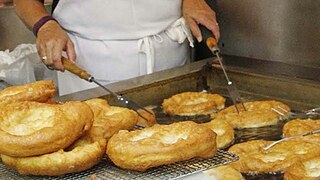
Malassada is a Portuguese fried pastry from the Azores. It is a type of doughnut, made of flattened rounds of yeasted dough, coated with sugar and cinnamon or accompanied with molasses.

Pithas are a variety of food similar to pancakes, dumplings or fritters, originating from the Indian subcontinent, common in Bangladesh and India. Pitha can be sweet or savoury, and usually made from a dough or batter, which is then steamed, fried or griddled. Very few varieties are oven-baked or boiled, and most are unleavened and cooked on a stovetop. Some versions may have a filling, garnish, or sauce. Few may be set or shaped after cooking. They are typically eaten as a snack with chai, or as treats during special occasions.

A filhó is a traditional pastry in Portugal and Northeastern Brazil.

Kokis is a deep-fried, crispy Sri Lankan food made from rice flour and coconut milk. Although considered as a traditional Sri Lankan dish, it is believed to have come from the Dutch. This is an important dish when celebrating Sinhala New Year and plays a major role in the festivities.

Sponge cake is a light cake made with eggs, flour and sugar, sometimes leavened with baking powder. Some sponge cakes do not contain egg yolks, like angel food cake, but most of them do. Sponge cakes, leavened with beaten eggs, originated during the Renaissance, possibly in Spain. The sponge cake is thought to be one of the first non-yeasted cakes, and the earliest attested sponge cake recipe in English is found in a book by the English poet Gervase Markham, The English Huswife, Containing the Inward and Outward Virtues Which Ought to Be in a Complete Woman (1615). Still, the cake was much more like a cracker: thin and crispy. Sponge cakes became the cake recognised today when bakers started using beaten eggs as a rising agent in the mid-18th century. The Victorian creation of baking powder by English food manufacturer Alfred Bird in 1843 allowed the addition of butter to the traditional sponge recipe, resulting in the creation of the Victoria sponge. Cakes are available in many flavours and have many recipes as well. Sponge cakes have become snack cakes via the Twinkie.
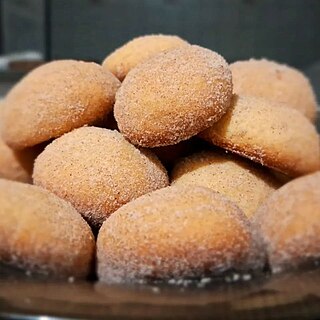
Areias are small traditional Portuguese pastries similar to cakes and biscuits. They are commonly coated with coarse-grain sugar, and sometimes cinnamon, which resemble sand for which areias are named after.

Pão de Ló is a Portuguese sponge cake made of eggs, sugar, and wheat flour. Unlike other cakes or breads, yeast or baking powder is generally not used. Rather, to provide volume, air is suspended into the cake batter during mixing.
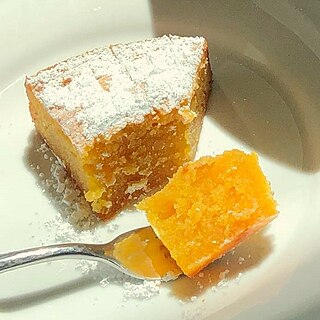
Toucinho do Céu is a Portuguese dessert made primarily of almonds, eggs, and sugar. While it is often described as a cake or tart, toucinho do céu remains largely free of flour and should not be mistaken for other Portuguese cakes and tarts containing almonds.



















